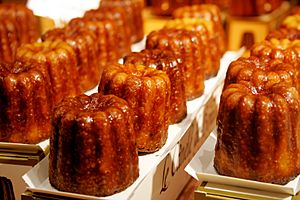Canelé facts for kids

Canelé
|
|
| Alternative names | Cannelé |
|---|---|
| Place of origin | France |
| Region or state | Bordeaux |
| Created by | Couvent des Annonciades |
| Serving temperature | Warm |
| Main ingredients | flour, milk, egg yolk, butter, vanilla, rum, cane sugar |
A canelé (say it: kan-leh) is a yummy French pastry that tastes like rum and vanilla. It has a soft, tender inside, like a custard, and a dark, crunchy outside that's a bit like caramel. Canelés are shaped like small cylinders with ridges, about five centimeters tall. They are a special treat from the Bordeaux region of France. Today, you can find them in many bakeries in France and around the world!
Contents
History of the Canelé
The canelé is thought to have started in the Couvent des Annonciades (a convent) in Bordeaux, France. This might have happened in the 15th or 18th century. The name "canelé" comes from the Gascon language, which was spoken in Bordeaux a long time ago.
Old Bakers and Their Rules
In the past, there was a food called canole in Limoges. It was a bread made with flour and egg yolks. This might be the same as the canaule sold in Bordeaux since the 1700s.
Special bakers called canauliers made these treats. They even had their own group, like a club or guild, which started in 1663. This group allowed them to make certain foods, including canaules. However, they were not allowed to use milk or sugar, because another group of bakers, the Pastry Chefs, had a special right to use those ingredients.
The canauliers and Pastry Chefs had disagreements about these rules. In 1755, a big decision was made in Versailles. It said that the canauliers could use milk and sugar, ending the Pastry Chefs' special right. Later, in 1767, rules were made to limit how many canaulier shops could be in a city. Even with strict rules, there were many canaulier shops in Bordeaux by 1785.
When the French Revolution happened, all these old groups and rules were ended. But even after that, records show that canaulier shops continued to exist.
The Canelé's Comeback
In the early 1900s, the canelé became popular again. We don't know exactly who did it, but a baker brought back the old canaulier recipe. This time, they added rum and vanilla to the dough. It's thought that the canelé got its famous ridged shape because the French word for "wave" sounds similar to "cannelure," which means "fluting" or "ridges."
The name "canelé" as we know it today is quite new. In 1985, as the pastry became super popular, the Brotherhood of the Canelé of Bordeaux was created. They removed the second "n" from the name, making it "canelé." This name became a special brand, protected by law. Ten years later, there were hundreds of canelé makers in the Aquitaine region of France. In 1992, people in Gironde (a part of Aquitaine) ate about 4.5 million canelés!
How Canelés Are Made and Eaten
Canelés are traditionally baked in small, ridged, cylinder-shaped molds. In the past, these molds were coated with beeswax to prevent sticking. Today, butter is often used instead.
You can find canelés in many different sizes. Depending on their size, they can be eaten for breakfast, as a snack, or as a dessert after a meal. Canelés also go well with red wine and other drinks.
Traditionally, canelés from Bordeaux are often sold in groups of 8 or 16. In Paris, some famous bakeries still spell it with a double 'n', like "cannelé of Bordeaux."
de:Bordeaux#Kulinarisches
See also
 In Spanish: Canelé para niños
In Spanish: Canelé para niños


